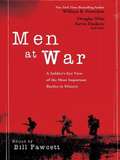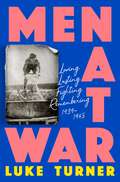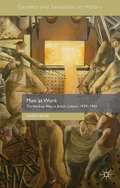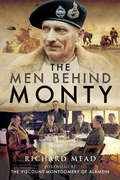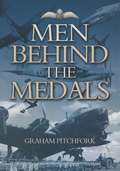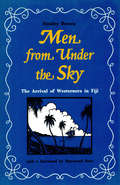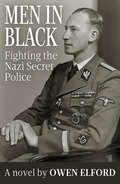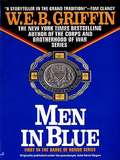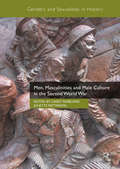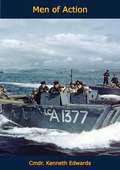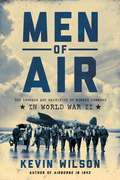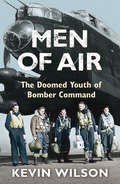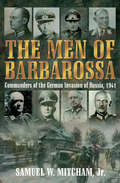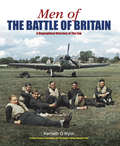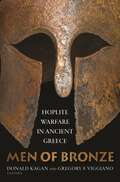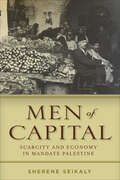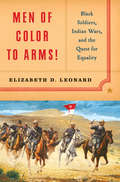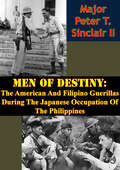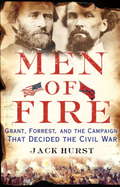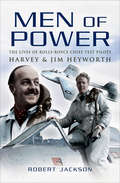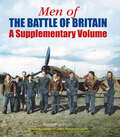- Table View
- List View
Men at War
by Bill FawcettEpic battles?as seen through the eyes of the men who fought them. From Gettysburg to D-Day, history?s most momentous battles have been recounted to the world on a grand scale. This book, for the first time ever, looks at man?s most epic battles from the point of view of the soldiers on the front lines; providing new insight into the great wars of history. Stories told by the Roman Legionaire, the British Doughboy, and the American Doggie, delve into these battles and battlefronts: Roman Legion Third Crusade under Richard Lionheart Waterloo, French under Napoleon American Civil War: Gettysburg WWI: Americans at Ardennes WWII: Japanese Island Defense WWII: D-Day, Americans at Normandy Marines at Chosin.
Men at War: Loving, Lusting, Fighting, Remembering 1939-1945
by Luke TurnerAs a child, Luke Turner was obsessed with the Second World War. He spent hours watching Sunday war films, poring over stories of derring-do and relishing in birthday trips to air museums. Lying in bed beneath Airfix fighter planes suspended from his ceiling, he would think about the men that might sit in their cockpits, and whether he could ever be one of them. Now, as an adult who has come to terms with a masculine identity and sexuality that is often erased from dominant military narratives, he undertakes a refreshingly honest analysis of his fascination with the war. In Men at War, Turner looks beyond the increasingly retrogressive and jingoistic ideal of a Britain that never was to recognise men of war as creatures of love, fear, hope and desire. From writers, filmmakers, artists and ordinary men - including those in his own family - Turner assembles a broad cast of characters to bring the war to life. There are conscientious objectors, a bisexual Commando, a pacifist poet who flew for Bomber Command, a transgender RAF pilot, a soldier who suffered in Japanese POW camps and later in life became an LGBT+ activist, and those who simply did what they could just to survive and return home to a complicated peace. As the conflict moves beyond living memory and the last veterans leave us, we are in danger of missing the opportunity to gain a true understanding of this rich history. By exploring a wartime experience that embraces sex, lust and the body as much as tactics and weaponry, Turner argues that the only way we can really understand the Second World War is to get to grips with the complexity of the lives and identities of those who fought and endured it.
Men at War: Loving, Lusting, Fighting, Remembering 1939-1945
by Luke TurnerAs a child, Luke Turner was obsessed with the Second World War. He spent hours watching Sunday war films, poring over stories of derring-do and relishing in birthday trips to air museums. Lying in bed beneath Airfix fighter planes suspended from his ceiling, he would think about the men that might sit in their cockpits, and whether he could ever be one of them. Now, as an adult who has come to terms with a masculine identity and sexuality that is often erased from dominant military narratives, he undertakes a refreshingly honest analysis of his fascination with the war. In Men at War, Turner looks beyond the increasingly retrogressive and jingoistic ideal of a Britain that never was to recognise men of war as creatures of love, fear, hope and desire. From writers, filmmakers, artists and ordinary men - including those in his own family - Turner assembles a broad cast of characters to bring the war to life. There are conscientious objectors, a bisexual Commando, a pacifist poet who flew for Bomber Command, a transgender RAF pilot, a soldier who suffered in Japanese POW camps and later in life became an LGBT+ activist, and those who simply did what they could just to survive and return home to a complicated peace. As the conflict moves beyond living memory and the last veterans leave us, we are in danger of missing the opportunity to gain a true understanding of this rich history. By exploring a wartime experience that embraces sex, lust and the body as much as tactics and weaponry, Turner argues that the only way we can really understand the Second World War is to get to grips with the complexity of the lives and identities of those who fought and endured it.
Men at Work: The Working Man in British Culture, 1939-1945 (Genders and Sexualities in History)
by Linsey RobbMen at Work explores the cultural portrayal of four essential wartime occupations: agriculture, industry, firefighting and the mercantile marine. In analysing a broad spectrum of wartime media (most notably film, radio and visual culture) it establishes a clear hierarchy of masculine roles in British culture during the Second World War.
The Men Behind Monty
by Richard MeadThe Men Behind Monty examines the role played by the staff in the victorious campaigns of Field Marshal Viscount Montgomery, Britain's most successful field commander since the Duke of Wellington.When Monty took command of Eighth Army in August 1942, he inherited the staff of his predecessor. He retained all the key members and most of them stayed with him not only from El Alamein to Tunis, but also in Sicily and Italy. When he took command of 21st Army Group in January 1944, many accompanied him to take up the most prominent positions on the HQ staff and the majority remained until the German surrender in May 1945.This fascinating work focuses not only on the senior officers responsible for the various staff branches, and notably on Monty's outstanding Chief of Staff, Freddie de Guingand, but also on his personal staff, the ADCs and personal liaison officers.The book sheds light on the work of the staff generally, and on their direct contribution to Monty's decisions, his sometimes difficult and controversial relationships with his superiors and allies.
Men Behind the Medals: A New Selection
by Air Commodore Graham PitchforkThis book pays tribute to the quite remarkable bravery of those young men who risked, and all too often lost, their lives for their country during the war. The author, himself a distinguished Royal Air Force officer, has singled out twenty-one men to represent 'the many' to whom he dedicated the book; but he has chosen them with care to illustrate, as far as possible, the wide scope of the duties of the Royal Air Force in wartime.
Men from Under the Sky
by Stanley Brown Raymond BurrThe cannibal kings of Fiji are gone, but their spirit lives on. Cannibalism in Fiji and the gruesome "earth ovens" are gone; the kai vavalagi, "the men from over the horizon," changed that, bringing their own brands of justice tempered by the musket, disease, and dissoluteness.There were giants in those days, Fijians and Westerners alike. This gripping and unique history of Fiji by Stanley Brown, a well-known Fiji "old-timer" and historian, is woven around the lives of eleven Western "giants," Europeans and Americans who had the greatest impact on each epoch. Not all these Westerners lived to tell the tale.This stirring narrative is replete with hair-raising accounts of battles and brutality. One incident of supreme savagery was reported by Lockerby, a famous trader, who reported that more than three hundred fifty old men, women and children were butchered after a battle: "As the canoes sallied back tot he mainland coast in the evening, the reddening sky silhouetted the bodies of children hanging from the mastheads." The earth-ovens were well-fueled that evening. But time and the tides of civilization tame the savage beast, and today Fiji is busy developing its economy, but the old accounts and stories still ring true.
Men from Under the Sky
by Stanley Brown Raymond BurrThe cannibal kings of Fiji are gone, but their spirit lives on. Cannibalism in Fiji and the gruesome "earth ovens" are gone; the kai vavalagi, "the men from over the horizon," changed that, bringing their own brands of justice tempered by the musket, disease, and dissoluteness.There were giants in those days, Fijians and Westerners alike. This gripping and unique history of Fiji by Stanley Brown, a well-known Fiji "old-timer" and historian, is woven around the lives of eleven Western "giants," Europeans and Americans who had the greatest impact on each epoch. Not all these Westerners lived to tell the tale.This stirring narrative is replete with hair-raising accounts of battles and brutality. One incident of supreme savagery was reported by Lockerby, a famous trader, who reported that more than three hundred fifty old men, women and children were butchered after a battle: "As the canoes sallied back tot he mainland coast in the evening, the reddening sky silhouetted the bodies of children hanging from the mastheads." The earth-ovens were well-fueled that evening. But time and the tides of civilization tame the savage beast, and today Fiji is busy developing its economy, but the old accounts and stories still ring true.
Men in Arms: A History of Warfare and Its Interrelationships with Western Society
by Sydney F. Wise Richard A. PrestonTextbook in military history traces the development of warfare and relates it to the development of Western society. This edition (fourth, 1979) revises previous editions and updates the text to 1990.
Men in Black: Fighting the Nazi Secret Police
by Owen ElfordMen in Black, first published in 1942, is a novel of Czech resistance to the occupying Germans in the early days of World War Two, and the struggle against the Gestapo, or Nazi secret police. The culminating act of the resistance is the assassination of Reinhard Heydrich, head of the Gestapo, which would lead to massive reprisals, including the razing of the village of Lidice and the execution of many of its inhabitants (the original subtitle of the book was “A Novel about Lidice,” but the book does not detail the massacre that occurred there). Men in Black is a moving, albeit fictional, account of the courage and sacrifice made by men and women during the war, and the brutality the Nazis imposed on those who dared to resist.
Men in Blue
by W.E.B. GriffinW. E. B. Griffin's bestselling series, THE CORPS and BROTHERHOOD OF WAR, have captured the pride and glory of the military community. Now he reveals a city police force with the same unique blend of realism, drama, and action. Here are the brave men and women behind the badge as you've never seen them before--their hopes and fears, their courage and heroism, sparked by a single, shocking event: the killing of a cop in the line of duty. .
Men, Masculinities and Male Culture in the Second World War
by Juliette Pattinson Linsey RobbThis edited collection brings together cutting-edge research on British masculinities and male culture, considering the myriad ways British men experienced, understood and remembered their exploits during the Second World War, as active combatants, prisoners and as civilian workers. It examines male identities, roles and representations in the armed forces, with particular focus on the RAF, army, volunteers for dangerous duties and prisoners of war, and on the home front, with case studies of reserved occupations and Bletchley Park, and examines the ways such roles have been remembered in post-war years in memoirs, film and memorials. As such this analysis of previously underexplored male experiences makes a major contribution to the historiography of Britain in the Second World War, as well as to socio-cultural history, cultural studies and gender studies.
Men of Action
by Cmdr. Kenneth EdwardsOriginally published in 1943, this is a unique collection of accounts relating to 19 distinguished Royal Navy Admirals and Captains of the Second World War Royal Navy.Written in the midst of World War II by Royal Navy Commander Kenneth Edwards, each contemporary portrait is filled with fascinating details. From the grey ships accompanying the convoys in the Atlantic to the seaborne Royal Navy Marines the struggle at sea during the Second World War is brought to life.An essential book for all R.N. historians to add to their collection!
Men of Air: The Courage And Sacrifice Of Bomber Command In World War Ii
by Kevin WilsonThe story of the everyday heroism of bomber crews in 1944, a turning point in the war against Germany. Bomber combat crews faced a wide array of perils as they flew over German territory. Bursts of heavy flak could tear the wings from their planes in a split second. Flaming bullets from German fighter planes could explode their fuel tanks, cut their oxygen supplies, destroy their engines. Thousands of young men were shot, blown up, or thrown from their planes five miles above the earth; and even those who returned faced the subtler dangers of ice and fog as they tried to land their battered aircraft back home. The winter of 1944 was the most dangerous time to be a combat airman in RAF Bomber Command. The chances of surviving a tour were as low as one in five, and morale had finally hit rock bottom. In this comprehensive history of the air war that year, Kevin Wilson describes the most dangerous period of the Battle of Berlin, and the unparalleled losses over Magdeburg, Leipzig and Nuremberg. Men of Air reveals how these ordinary men coped with the extraordinary pressure of flying, the loss of their colleagues, and the threat of death or capture. Brilliantly placing these stories within the context of The Great Escape, D-Day, the defeat of the V1 menace, and more, Wilson shows how the sheer grit and determination of these "Men of Air" finally turned the tide against the Germans.
Men Of Air: The Doomed Youth Of Bomber Command
by Kevin WilsonThe story of the everyday heroism of British bomber crews in 1944 - the turning point year in Bomber Command's war against Germany.There were many ways for a combat crew to die during Bomber Command's war of 1944. Over German territory, bursts of heavy flak could tear the wings from their planes in a split second. Flaming bullets from German fighter planes could explode their fuel tanks, cut their oxygen supplies, destroy their engines. In the spring of that year, thousands of young men were shot, blown up, or thrown from their planes five miles above the earth; and even those who returned faced the subtler dangers of ice and fog as they tried to land their battered aircraft back home.The winter of 1944 was the most dangerous time to be a combat airman in RAF Bomber Command. The chances of surviving a tour were as low as one in five, and morale had finally hit rock bottom. In this comprehensive history of the air war that year, Kevin Wilson describes the most dangerous period of the Battle of Berlin, and the unparalleled losses over Magdeburg, Leipzig and Nuremberg. He tells how ordinary men coped with constant pressure of flying, the loss of their colleagues, and the threat of death or capture. And, by telling the story of the famous events of this period - the Great Escape, D-Day, the defeat of the V1 menace - he shows how, through sheer grit and determination, the 'Men of Air' finally turned the tide against the Germans.
Men Of Air: The Doomed Youth Of Bomber Command
by Kevin WilsonThe story of the everyday heroism of British bomber crews in 1944 - the turning point year in Bomber Command's war against Germany.There were many ways for a combat crew to die during Bomber Command's war of 1944. Over German territory, bursts of heavy flak could tear the wings from their planes in a split second. Flaming bullets from German fighter planes could explode their fuel tanks, cut their oxygen supplies, destroy their engines. In the spring of that year, thousands of young men were shot, blown up, or thrown from their planes five miles above the earth; and even those who returned faced the subtler dangers of ice and fog as they tried to land their battered aircraft back home.The winter of 1944 was the most dangerous time to be a combat airman in RAF Bomber Command. The chances of surviving a tour were as low as one in five, and morale had finally hit rock bottom. In this comprehensive history of the air war that year, Kevin Wilson describes the most dangerous period of the Battle of Berlin, and the unparalleled losses over Magdeburg, Leipzig and Nuremberg. He tells how ordinary men coped with constant pressure of flying, the loss of their colleagues, and the threat of death or capture. And, by telling the story of the famous events of this period - the Great Escape, D-Day, the defeat of the V1 menace - he shows how, through sheer grit and determination, the 'Men of Air' finally turned the tide against the Germans.
Men of Barbarossa: Commanders of the German Invasion of Russia, 1941
by Samuel W. Mitcham Jr.&“&‘A must read&’ for Eastern Front fans, as well as anyone seeking to find out more about the titanic struggle between Hitler and Stalin.&” —Armchair General This book not only tells the story of Operation Barbarossa, the German invasion of the Soviet Union, but describes the expertise, skills, and decision-making powers of the men who directed it, including new insights into the invasion&’s many tactical successes, as well as its ultimate failure. This objective is massive in scope, because Operation Barbarossa was massive in scale, arguably the largest military operation of all time. The campaign also changed the world forever. Before Barbarossa, Hitler&’s Wehrmacht seemed invincible, like an unstoppable force of nature. No one, it seemed, could check the Führer&’s ambitions, much less defeat him. Barbarossa changed all of that. By the end of 1941, Allied victory seemed to be a very real possibility. Few would have bet on it sixteen or seventeen months earlier. Pitting Germany in total war against the Soviet Union on a 1,000-mile front, Operation Barbarossa was truly staggering in its magnitude. Wars, however, are not fought by numbers, they are fought by men. In this book we learn of the villains and heroes, famous commanders and unsung leaders, and about those who were willing to stand up to the Führer and those who subordinated themselves to his will. The result is a book that casts a fresh perspective on one of history&’s most crucial military campaigns.
Men of The Battle of Britain: A Biographical Dictionary of the Few
by Kenneth G. WynnSince it was first published in 1989, Men of the Battle of Britain has become a standard reference book for academics and researchers interested in the Battle of Britain. Copies are also owned by many with purely an armchair interest in the events of 1940.The book records the service details of the airmen who took part in the Battle of Britain in considerable detail. Where known, postings and their dates are included, as well as promotions, decorations and successes claimed flying against the enemy. There is also much personal detail, often including dates and places of birth, civilian occupations, dates of death and place of burial or, for those with no known grave, place of commemoration. There are many wartime head-and-shoulders photographs. Inevitably the high achievers who survived tend to have the longest entries, but those who were killed very quickly, sometimes even on their first sortie, are given equal status.The 2015 third edition will include new names and corrected spellings, as well as many new photographs. Plenty of the entries have been extended with freshly acquired information. The stated nationalities of some of the airmen have been re-examined and, for example, one man always considered to be Australian is now known to have been Irish.
Men of Bronze: Hoplite Warfare in Ancient Greece
by Donald Kagan and Gregory F. ViggianoA major contribution to the debate over ancient Greek warfare by some of the world's leading scholarsMen of Bronze takes up one of the most important and fiercely debated subjects in ancient history and classics: how did archaic Greek hoplites fight, and what role, if any, did hoplite warfare play in shaping the Greek polis? In the nineteenth century, George Grote argued that the phalanx battle formation of the hoplite farmer citizen-soldier was the driving force behind a revolution in Greek social, political, and cultural institutions. Throughout the twentieth century scholars developed and refined this grand hoplite narrative with the help of archaeology. But over the past thirty years scholars have criticized nearly every major tenet of this orthodoxy. Indeed, the revisionists have persuaded many specialists that the evidence demands a new interpretation of the hoplite narrative and a rewriting of early Greek history. Men of Bronze gathers leading scholars to advance the current debate and bring it to a broader audience of ancient historians, classicists, archaeologists, and general readers.After explaining the historical context and significance of the hoplite question, the book assesses and pushes forward the debate over the traditional hoplite narrative and demonstrates why it is at a crucial turning point. Instead of reaching a consensus, the contributors have sharpened their differences, providing new evidence, explanations, and theories about the origin, nature, strategy, and tactics of the hoplite phalanx and its effect on Greek culture and the rise of the polis.The contributors include Paul Cartledge, Lin Foxhall, John Hale, Victor Davis Hanson, Donald Kagan, Peter Krentz, Kurt Raaflaub, Adam Schwartz, Anthony Snodgrass, Hans van Wees, and Gregory Viggiano.
Men of Capital: Scarcity and Economy in Mandate Palestine
by Sherene SeikalyMen of Capital examines British-ruled Palestine in the 1930s and 1940s through a focus on economy. In a departure from the expected histories of Palestine, this book illuminates dynamic class constructions that aimed to shape a pan-Arab utopia in terms of free trade, profit accumulation, and private property. And in so doing, it positions Palestine and Palestinians in the larger world of Arab thought and social life, moving attention away from the limiting debates of Zionist-Palestinian conflict. Reading Palestinian business periodicals, records, and correspondence, Sherene Seikaly reveals how capital accumulation was central to the conception of the ideal "social man. " Here we meet a diverse set of characters--the man of capital, the frugal wife, the law-abiding Bedouin, the unemployed youth, and the abundant farmer--in new spaces like the black market, cafes and cinemas, and the idyllic Arab home. Seikaly also traces how British colonial institutions and policies regulated wartime austerity regimes, mapping the shortages of basic goods--such as the vegetable crisis of 1940--to the broader material disparities among Palestinians and European Jews. Ultimately, she shows that the economic is as central to social management as the political, and that an exclusive focus on national claims and conflicts hides the more complex changes of social life in Palestine.
Men of Color to Arms!: Black Soldiers, Indian Wars, and the Quest for Equality
by Elizabeth D. LeonardThe story of the black soldiers who helped save the Union, conquer the West, and build the nation. In 1863, at the height of the Civil War, Frederick Douglass promised African Americans that serving in the military offered a sure path to freedom. Once a black man became a soldier, Douglass declared, "there is no power on earth or under the earth which can deny that he has earned the right to citizenship in the United States." More than 180,000 black men heeded his call to defend the Union--only to find the path to equality would not be so straightforward. In this sharply drawn history, Professor Elizabeth D. Leonard reveals the aspirations and achievements as well as the setbacks and disappointments of African American soldiers. Drawing on eye-opening firsthand accounts, she restores black soldiers to their place in the arc of American history, from the Civil War and its promise of freedom until the dawn of the 20th century and the full retrenchment of Jim Crow. Along the way, Leonard offers a nuanced account of black soldiers' involvement in the Indian Wars, their attempts to desegregate West Point and gain proper recognition for their service, and their experience of Reconstruction nationally, as blacks worked to secure their place in an ever-changing nation. With abundant primary research, enlivened by memorable characters and vivid descriptions of army life, Men of Color to Arms! is an illuminating portrait of a group of men whose contributions to American history need to be further recognized.
Men Of Destiny: The American And Filipino Guerillas During The Japanese Occupation Of The Philippines
by Major Peter T. Sinclair IIThe American and Filipino guerrillas that fought against the Japanese occupation of the Philippines were key in providing direction to resistance efforts and in the eventual liberation of the islands. The guerrillas escaped the aggressive counter-guerrilla efforts of the Imperial Japanese Army. The Japanese failure to deal with isolated soldiers and civilians provided the time they needed to organize into guerrilla groups and prepare for American forces liberation of the Philippines. This analysis of American and Filipino insurgents covers the effectiveness of Japanese counter guerrilla efforts, the intelligence structure created by General Douglas MacArthur's staff to support the guerrillas, the guerrilla's contributions to the liberation of the Philippines, and it examines how Americans would form guerrilla groups and fight as insurgents behind enemy lines if circumstances warranted. Additionally, it provides general insight as to how resistance movements form.
Men of Fire: Grant, Forrest, and the Campaign That Decided the Civil War
by Jack HurstDeep in the winter of 1862, on the border between Kentucky and Tennessee, two extraordinary military leaders faced each other in an epic clash that would transform them both and change the course of American history forever. Brigadier General Ulysses S. Grant had no significant military successes to his credit at the outset of the campaign. He was barely clinging to his position within the Union Army--he had been officially charged with chronic drunkenness only days earlier, and his own troops despised him. His opponent was as untested as he was: an obscure lieutenant colonel named Nathan Bedford Forrest. The two men held one thing in common: an unrelenting desire for victory at any cost. A riveting account of the making of two great military leaders, and two battles that transformed America forever, Men of Fire is destined to become a classic work of military history.
Men of Power: The Lives of Rolls-Royce Chief Test Pilots Harvey & Jim Heyworth
by Robert JacksonThe story begins in 1940 when Harvey Heyworth was leading No. 79 Squadron RAF defending north-eastern England from Luftwaffe raids made by bombers based in Norway and Denmark and then later in the Battle of Britain when the unit moved south. During late 1940 and up to June 1941 Heyworth led his squadron in defense of Bristol and Swansea operating by night and day. By 1942 he had amassed 4,000 flying hours. Harvey then joined Rolls-Royce test flying early British jet aircraft including the famous Gloster-Whittle and test-bed Wellington bombers powered by the new jet engines.In 1944 Harvey's brother Jim also joined Rolls, having flown with No. 12 Squadron in Bomber Command. The story then unfolds into the development of the Trent turboprop and the Avon jet engines. Development work on a variety of test-bed aircraft was ongoing and included some weird combinations of airframe and engine.Jim succeeded his brother as chief test pilot in 1958 and flew 82 different aircraft types. He recounts his experiences of piloting the Vulcan bomber, Lightning and the 'Flying Bedstead' VTOL test rig.
Men of the Battle of Britain: A Supplementary Volume
by Kenneth G. Wynn“Tells about various details of data, squadrons, training, life path, passport photos and more. This supplement contains addition for about 350(!) airmen.” —Aviation Book ReviewsSince it was first published in 1989, Men of the Battle of Britain, the complete third edition of which was published in 2015, has become a standard reference book for academics and researchers interested in the Battle of Britain. This remarkable publication records the service details of every airman who took part in the Battle of Britain, and who earned the Battle of Britain Clasp, in considerable detail. Where known, an individual’s various postings and their dates are included, as are promotions, decorations, and successes claimed while flying against the enemy. There is also much personal detail, often including dates and places of birth, civilian occupations, dates of death and place of burial or, for those with no known grave, place of commemoration. There are many wartime head-and-shoulders photographs.Inevitably, the passage of time ensures that there is a constant reevaluation of the wealth of information contained within Men of the Battle of Britain. At the same time, since the 2015 edition it has been possible to expand many individual entries, some 330 in total, to give some idea of the wider social context around the aircrew who earned the Battle of Britain Clasp. This has been achieved by reference to existing sources, including information supplied by The Few themselves and their relatives over many years, as well as new research.This invaluable supplement to the 2015 edition ensures that these additions and revisions are available to all researchers, historians, enthusiasts and general readers.
